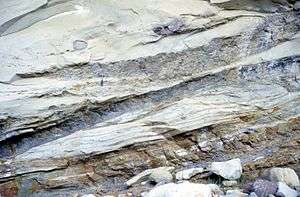Rip-up clasts

Shale rip-up clasts in a nearshore marine sandstone, Matilija Fm. Topatopa Mountains, California.

A giant shale rip-up clast at the base of a high-density turbidite, Cozy Dell Fm. Topatopa Mountains, California.
Rip-up clasts are pieces of shale or mudstone created when an erosive current containing suspended sediment flows over a shale bed, tears up pieces of it, and carries these "rip ups" some distance. Because clay can be quite cohesive, even when freshly deposited, large clasts of shale can be ripped up, transported and subsequently preserved when the eroding current finally deposits its sediment. Shale rip-up clasts are often found at the base of sandy turbidites, in lag deposits at the base of channelized sandstones, and associated with subaqueous dunes and bars.[1][2]
Notes and references
This article is issued from Wikipedia - version of the 6/29/2013. The text is available under the Creative Commons Attribution/Share Alike but additional terms may apply for the media files.